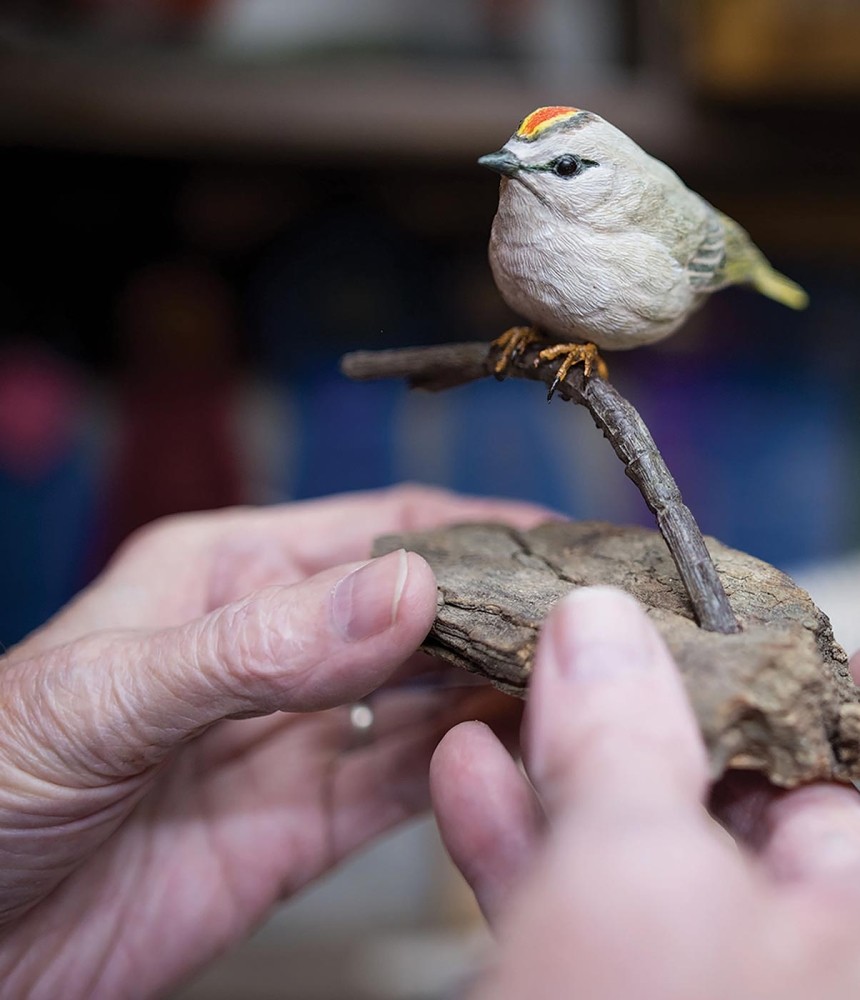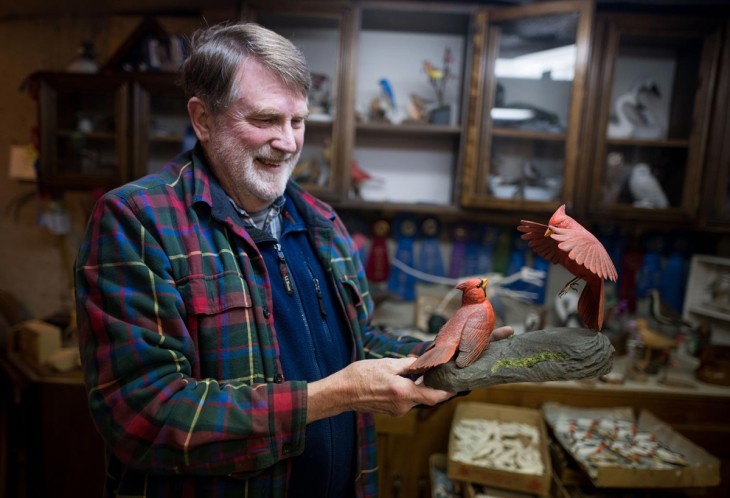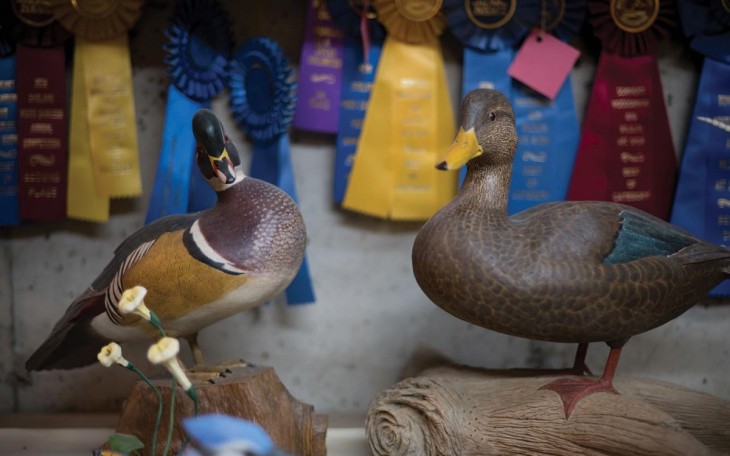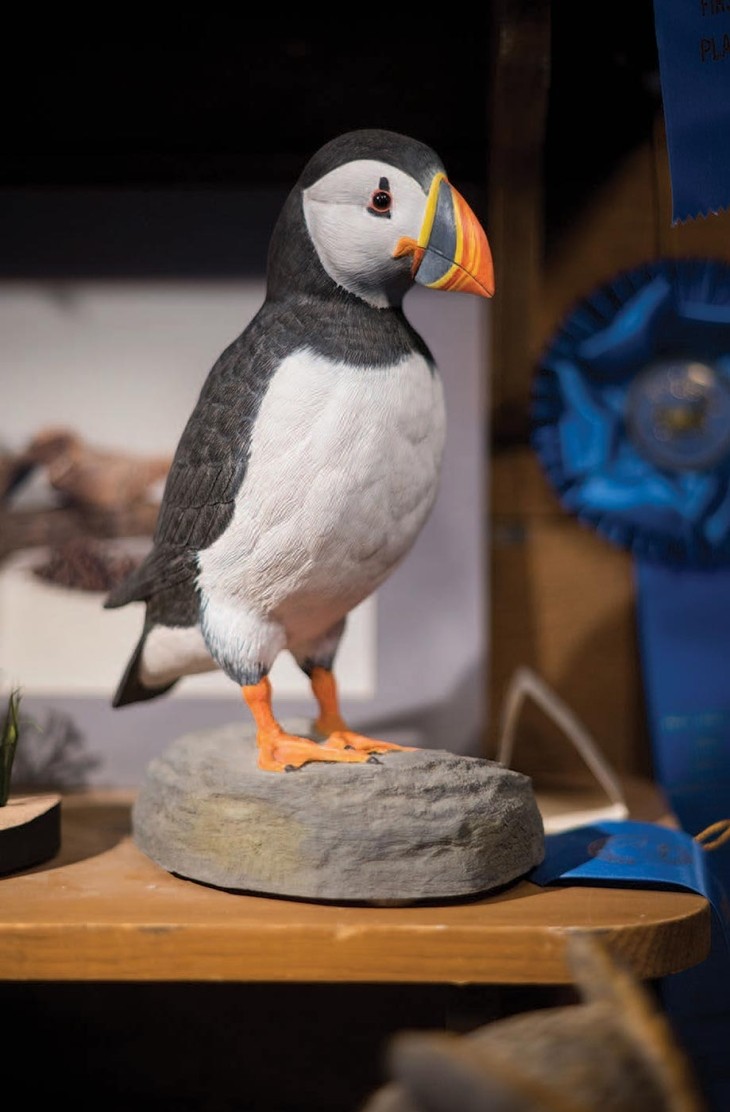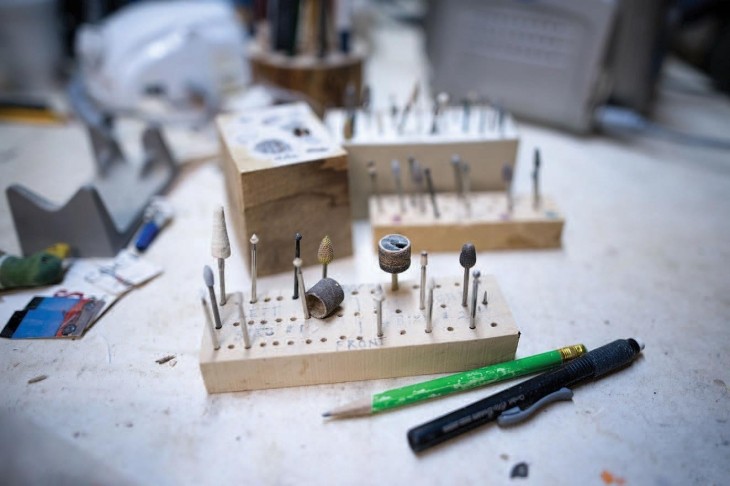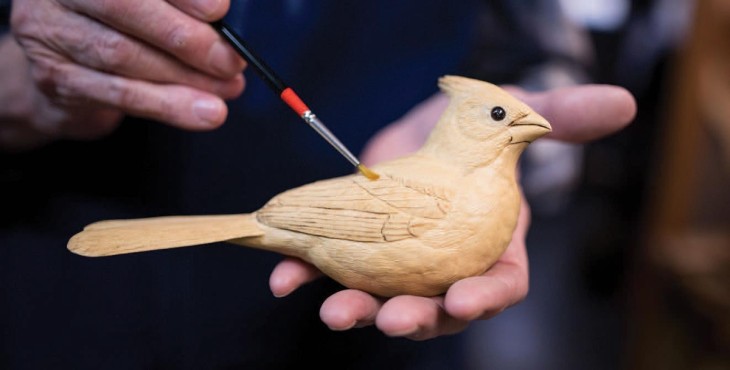Woodcarver George Calef has fond memories of sitting at his grandmother’s knee, almost 80 years ago, as she looked out the window at the birds flitting around her birdfeeder. “I’d say, ‘What do we have?’” he recalls. “And she’d say, ‘Oh look, George, there’s a chickadee,’ or, ‘The grosbeaks are back.’” These days, Calef spends countless hours noticing the tiniest features of birds, including species that would never visit a birdfeeder. Although he came to woodcarving in a roundabout way, he is now widely recognized as one of the leading woodcarvers in the Northeast, with awards from numerous organizations, including the New England Wood Carvers (NEWC), the Ward Foundation, and the Maine Wood Carvers Association.
Calef had an interest in art at a young age and might have pursued formal training, had he not been obligated to work at the general store founded by his great-grandmother, Calef ’s Country Store in Barrington, New Hampshire, just down the street from where he still lives today. Calef honed his knife skills carving meat at the deli counter of the family business. He honed his art skills through a back-of-a-magazine correspondence course.
Calef eventually took over ownership of the store and then opened a second, separate business: George Calef ’s Fine Foods. Despite the long work hours, he never lost his interest in art. For about a decade, beginning in the late 1990s, Calef and his wife Arvilla traveled to the League of New Hampshire Craftsmen’s Fair each summer, where Calef passed the time watching chainsaw carvers work their gas-fueled magic, turning hunks of white pine into sculptures of black bears. During visits to the fair, Calef learned from New Hampshire wood artists, including bird-carver Ira Frost and woodland creature-creator Laury Nichols.
Eventually, Calef decided to try to make his own sculptures, using pine logs he was otherwise planning to cut up for firewood. “I was burning a lot of wood in those days,” Calef says. “I said, ‘You know, there’s a better use for that wood.’ So, I started carving chainsaw bears.”
When winter drove him inside and the electric chainsaw proved unwieldy in the close quarters of his basement, Calef pivoted to carving smaller wildfowl decoys, a process more conducive to that indoor space. After closing up the store each night, he spent at least an hour carving. “You’d be surprised what you can get done in an hour a day, whether it’s pulling weeds or carving a duck,” he says.
Soon he traded in the pine logs for tupelo wood and made a few attempts at carving a female bufflehead before eventually submitting his first-ever painted bird to the Rochester Fair. That carving was, by his candid assessment, “bad,” but it garnered a blue ribbon and encouraged him to continue improving his skills.
Calef is self-taught, combining patience, trial and error, and instructions from carving magazines to master his craft. After passing on the general store to his son James in 2006, he finally had the time to tackle his artistic pursuits in earnest, moving from the fairground circuit to regional, national, and international competitions.
Wildfowl decoys have a rich history as both practical hunting gear and folk art, although today, most goose and duck hunters use mass-produced, rubberized plastic models. Still, decoy woodcarving traditions are upheld through annual juried competitions. Calef describes how judges crowd around a water tank to observe the decoys in action, watching for the slightest imperfections such as a dip of the beak or a wobble in the wake. The judges gradually disqualify and remove decoys until only one winner remains afloat. They sometimes leave decoys in the water for more than two hours before making their final decision.
Calef has done well at these competitions, which he credits in part to his success carving waterfowl models that are finely balanced for buoyancy. “It’s hollow on top and it’s weighted down bottom,” Calef explains. “So when [the judges] tip it over, it will self-right.”
He has also expanded to carving non-game birds, and he’s taken first place at the Ward World Championship Wildfowl Carving Competition multiple times, securing blue ribbons for replicas of a variety of species, from northern shoveler ducks to Atlantic puffins.
While his carving draws on his personal observations of birds, Calef also uses field guides, bird books, and print magazines as visual references; his basement woodshop is filled with dogeared copies of books such as The Passenger Pigeon and bookmarked issues of Birds & Blooms magazine. Immersed in the ornithological world, Calef has learned more about birds than he ever expected, tracking the interspecies similarities of feather texture, shape, and function, knowledge that is reflected in his carvings.
Calef orders shoebox-size pieces of tupelo wood from the southeastern United States, where the mild winters mean the wood won’t have inconsistent textures due to varied seasonal growth rings, which are hard in winter and soft in summer.
“My forte is the detail,” Calef says. “And every little detail mark on my work is done one at a time. So if you’re putting pressure on the wood with your tool, the mark will vary when you’re pressing on the hard wood versus the soft, and I don’t want it to vary.”
Tupelo hunk in hand, Calef sketches outside and top views of the future decoy and lines them up before creating a pattern out of an old cereal box. From there, he removes the waste wood with a bandsaw, and the decoy begins to take shape.
“The saying is, ‘Take off everything that doesn’t look like a bird,’” Calef jokes. “But it’s not as easy as that.”
Calef ’s collection of woodcarving tools has grown over the years, from rows of chisels and gouges and his old hammer with a broken face to the electric rotary dental tools that many woodcarvers have added to their arsenals. His most important tool – and the “biggest secret” he shares with his carving students – is a sharp-pointed woodburner, which, with the proper hand speed, pressure, and temperature, can create the fine, feathered lines needed for a realistic decoy. That woodburning technique took Calef about five years to master.
The painting is just as important as the carving, which can be a challenge for those who get into the craft to work with wood and suddenly find themselves picking up a paintbrush. “It’s such a diverse difference in skills between the carving and the painting that it can be a little intimidating,” Calef says. “But the challenge is what we do it for.”
Calef admires the patina created on oil-painted decoys, but he uses acrylic for his own work, as the quick-drying nature of that paint flows better with his hands-on process. “I usually hold the piece in my hand while I’m working on it,” he says. “Say you just painted the left wing and you want to paint the right wing – you can’t turn it over with oil paint, because it’s wet. In 10 minutes, acrylic is dry to the touch.” He says it’s also possible to create a fine patina with acrylic paint.
For better or for worse, Calef ’s hobby has become his profession. While some of his more detailed waterfowl decoys fetch more than $7,000 a pop, he’s lucky to pull in $10 an hour after spending a week carving a chickadee. Calef keeps the lights on by carving smaller, decorative birds that he sells at the year-round holiday shop, The Christmas Dove, around the corner from his home. Near the holidays, Calef sets up in a corner of the shop, delighting onlookers with woodcarving demonstrations as the sawdust flies.
At the end of the day, it’s not about the money, the prestige, or even the birds for Calef, but about the peace of mind the work brings: “With a piece of wood in one hand and a tool in the other, the rest of the world is gone, and you’re destressed.”


